Value Chain Analysis of Beef Cattle Production in Wolaita Zone: The Case of Damot Gale District, Wolaita Sodo, Boditi and Areka Towns, Southern Ethiopia - Juniper Publishers
Juniper Publishers- Open Access Journal of Environmental Sciences & Natural Resources
Value Chain Analysis of Beef Cattle Production in Wolaita Zone: The Case of Damot Gale District, Wolaita Sodo, Boditi and Areka Towns, Southern Ethiopia
Authored by Zekarias Bassa
Abstract
Beef cattle production and value addition practices are known as major income earning activities and economic stay of the farmers, brokers, traders, hotels and restaurants and also provide huge financial support town for administrative in Wolaita area, yet attention given to the sector is not comparable to the economic value the sector own. This study, therefore, was initiated to identify value chain actors and their function in the chain, investigate factors affecting value added in beef production and economic role beef value chain for districts. Both primary and secondary data were used for this study. Primary data were collected from 102 sampled farmers, 21 hotels and restaurants, 3 town administrative (Wolaiyta Sodo, Areka, Boditi) and 15 experts from different strata. Before the household survey, key informant interview and focus group discussions were conducted using 20 small scale farmers, 5 hotels and restaurants, 1 town administrative and 1 expert.
Keywords: Beef Cattle; Value Chain; Value Added; Income; Market; Institution
Introduction
Descriptive Statistics and Econometric data analysis techniques were employed to analyze socioeconomic information; extents of value added in meat production and identify determinants of value added in beef production. The study result indicated that farmers, hotels and restaurants, government, brokers, traders and consumers were the major beef value chain actors. The economic value of meat produced annually in Wolaita and Areka town exceeds 0.32 billion Ethiopian Birr (equivalent to 10 million USA dollars) and 53 million Ethiopian Birr (equivalent to 1.9 million USA dollars) respectively. The total number of beef cattle slaughtered in one fiscal year was more than 10 thousand and 2300 in Wolaita Sodo and Areka Town, respectively. The study confirmed that number of beef cattle slaughtered in towns varies across season in relation to informal institutions celebrated (Meskel and other festivals occurrences) and income earning capability of communities in the district.
The major source of beef cattle of small scale farmer for beef value addition through fattening were beef cattle purchased from market (82.5%) and ox kept at home (32.5%). The study indicated that livestock plays vital role by supporting town administrative as revenue source that calculated to be more than one million Ethiopian Birr in Areka annually. The econometric regression result justified that extent of value added in beef production depends on total land owned, amount off-farm and agricultural income earned annually at household level ,amount of brokers payment for market facilitation service, extent of costs incurred in informal institutional circumstances.
From explanatory variables regressed over level of value added, amount of off-farm and agricultural income and extent of payment made to brokers positively affected the extent of value added in beef production, while amount cost incurred for informal institutional cases and total land owned negatively affected value added by producers in beef production. Hence, training and capacitating farmers, giving due attention and policy supporting to livestock sector in general and beef value chain in particular that is comparable to the role they play, optimizing the informal institutional cases linked positively with beef value chain, improving credit access, market infrastructure development, linking producers to market and its benefits and establishing in cooperatives believed play a significant role for maximization of the sector productivity.
Materials and Methods
Description of the Study Area
The study was conducted in Wolaita zone of Southern Nation Nationalities and People Regional State, Ethiopia. The beef value chain study was undertaken in rural administrative of Damot Gale district, Wolaita Sodo town and Areka town in Wolaita zone. The study Woreda and town administrative was selected based on past experience in beef cattle production, livestock population potential and value addition practices carried in the district. The household survey carried out in two kebele namely Ade Damota and Wosh Gale in Damot Gale district.
Damot Gale District
Damot Gale is one of the woredas (districts) in the Southern Nations, Nationalities, and Peoples' Region of Ethiopia. Part of the Wolayita Zone, Damot Gale is bordered on the southwest by Sodo Zuria, on the northwest by Boloso Sore and Damot Pulasa, on the north by the Hadiya Zone, on the east by Duguna Fango, and on the southeast by Damot Weyde. The administrative centre of Damot Gale is Boditi. It is located at 139 km south west of the Hawassa town which is the capital of southern regional state and 365 km from Addis Ababa in the southern direction. Geographically, it is located between 6° 53'-7° 6' 30" north latitude and 37° 46'-37° 58' 40" east longitude.
It has an altitude ranging from 1501-2950 meters above mean sea level. Mount Damota is the highest peak in the area. The study area covers an area of 24285.861 hectare. Damot Gale district is divided into three basic traditional agro-climatic zones such as Dega or highland (25.3%), Woina dega or midland (61.2%) and Kola or lowland (13%) (WARD Farming and Natrural Resource management office). Woina dega dominates the study area which has bimodal distribution of rainfall. Mean annual rainfall ranges between 1001-1400 mm [1].
Sampling techniques and sample size
Consultation and discussion was made with Woreda professionals and experts from Woreda Office of Agriculture (WOA), Tax and revenue authority of the area, and town administrative. A purposive sampling technique was used for selection of the study location followed by random sampling for kebele and household selection. Based on secondary information collated and literature reviewed, 120 farmers household were interviewed from two kebele of Damot Gale. From these, 65 small scale farmers interviwed from Woshgale Kebele and 55 housholds interviwed from Adde Damota Kebele. In addition to household survey key informant interview and focus group discussion was made at Kebele, Woreda and town level. The key informant included 30 farmers from two kebele, 6 experts from Sodo, Areka and Boditi towns and 5 livestock experts from Damot Gale Woreda. From three twon administrative the number of household interviewed amounts to 10 from Wolaiyta sodo, 5 from Boditi and 6 from Areka town administrative.
Results and Discussion
Socioeconomics information of the study district
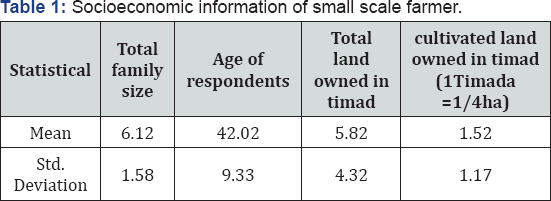
The average age of the small scale farmers' household head was 42. However, it ranges in between 25 and 88. The proportion of sampled producers whose age lies in the range between 25 and 62 was 98.1%. The remaining 1.9 % sampled pastoralists were aged more than 69 years. This findings show that majority the cattle producers were in the age range of active labour force and only few known to be dependant age category. Thus, this is very important with respect to the quantity supply of beef cattle value addition and household participation in value addition activities (Table 1).
The family size distribution shows that the average family size of Damot Gale small scale farmers pastoralists is 6. However, the range of family size for sampled farmers is between 3 and 9. From whole sample households in the area, the proportion of households with family size of 3 to 5 family sizes were 13%, 6 to 8 were 64 % and 9 were 3%. The survey result reveals that majority of households belong to large and medium family size category. The proportion of households with low and very high family size is few.
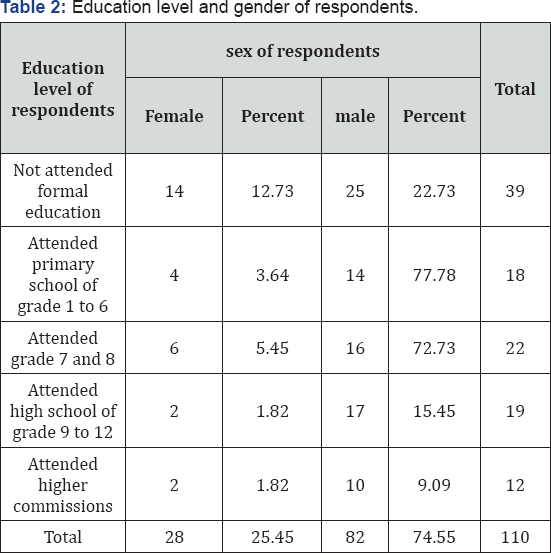
The result in the Table 2 revealed that 39 % of sampled small scale farmer households did not attend formal education, from which 12.73% were female household member and 25 were male household member. From small scale farmers household who attended formal education (attended from primary grade to high school) was 61%. The gender distribution of farmer households with respect to formal education attendance indicate that when it passed from primary to secondary and then higher commission, the proportion of male household member that participated in schooling increased, in comparison to female household heads.

Source: own survey 2016
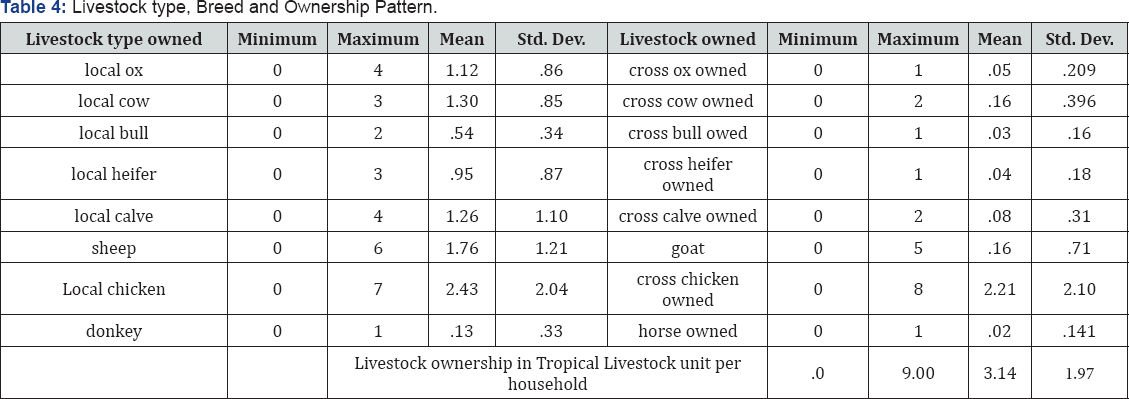
The table 3 above indicated that the proportion of farmers attended formal education and informal education varied across kebele in the study district. The proportion farmers attended formal educations in Woshi Gale are relatively higher than that of Ade Damota farmers. Since the residents of Woshi Gale farmers are live in more nearer destination to woreda town (Boditi) and related infrastructures, their level of participation in formal education is higher than that of Adde Damot District. The study result indicated that through improving access to infrastructures, it is possible to increase the level of education participation for farmers in formal education.

The study justified that livestock type, breed and quantity of ownership varies across small scale farmers. The mean ownership of local cattle, shot and equine owned per farmers was 1, 0.96 and 0.075 respectively. The average number of cross cattle owned per household was very few this indicates low adoption of improved cattle breed technologies in the district that negatively affects the value addition practices (Table 4). The study indicated proportion of religion type across small scale farmers varies in different kebele of Damot Gale district. The major religions observed in the study district were protestant, orthodox, catholic and Muslim. From respondent farmers in two kebele of the district, 62% were protestant, 29 % orthodox, 6% Muslim and 2% Catholic (Table 5).
Even if the proportion varies, Market ox and home ox observed as source of more than 50% producers for fattening in value addition. The study confirmed that majority of the farmers used beef cattle for value addition by purchasing from the market, ox from home after ploughing, private and ox for profit share and borrowing money and purchased ox for profit. The major sources of beef cattle for fattening in the study district identified as home grown cattle, market ox, share in and out ox and ox purchased by credit capital. Since beef cattle fattening is one of the main income sources for small scale farmers in the district, producers used beef cattle from different source for fattening (Table 6).

Beef cattle Value chain actors and their function in the chain
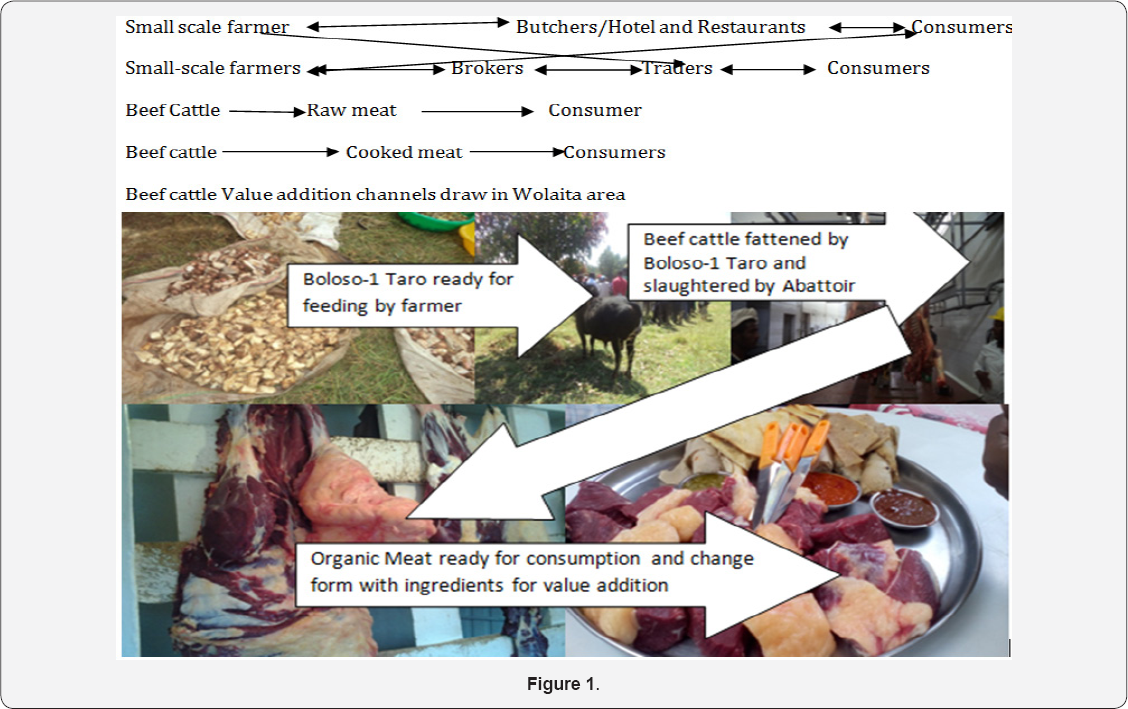
The major actors in Beef cattle value chain include small scale farmer, brokers, trekkers, truckers, hotels and restaurants, butcheries, abattoirs, town municipality, traders and livestock and fihery departments and consumers. As its enrollment in the value chain and financial capacity they play the level of enrollment in the value chain, the extent of value added varies across value chain actors (Figure 1). The major value chain actors in beef cattle and meat production comprised of small scale farmers, brokers, hotels and restaurants, government, trekkers and truckers. The study in line [2,3], where the main actors of beef value chains are input supplier, producer, collectors, traders, cooperatives, brokers, abattoirs, butchers, processors and consumers.
i. Small scale farmer: Is one of the main actors in beef value chain. The major function of producer in beef value chain was supplying competent beef cattle, initial and final marketing price information provision and selling beef cattle. The study result indicated that 8% of producers justified farmers function in the value chain was supplying competent beef cattle, informing initial price ad final market price of cattle for 2% producers, supplying competent cattle, informing final price and selling for 57% producers. From interviewed farmers 43% confirmed that the major function of small scale farmer in the value chain was fattening, supplying beef cattle and providing initial market price for marketing in the district.
The major challenges for fatteners farmers in the beef value chain were unavailability other value addition channels, financial shortage to truck and take part in central markets. In addition to these, since the farmers feedlot the aged beef cattle after long year ploughing experience and invest cost for prolonged period in feeding and management to have competent beef cattle it was must to sell the they brought to the market to fulfil major institutional and economical demands. This study confirmed that linking the small farmers to market and its benefits, forming in cooperatives, undertaking demonstration in un-aged beef cattle and its benefits has to be one the major step to be carried out by stockholders in the value chain.
ii. Brokers: Brokers are one of the major actors in beef value with function of mediating the marketing system between seller and buyers, providing market information (price, value added, market time and conditions), price setting and act in buyers and sellers side. Brokers own double benefits that they get from both buyers and sellers. Brokers are known as the second intermediate source of market information and plays vital role in price setting.
iii. Hotels and Restaurants: Hotels and restaurants are known as value addition actors in the chain. The significant function of Hotels and restaurants are creating forms and add value by including locally available ingredients. This study indicated that Hotels and restaurants known as over exploiters of the benefits through simple and short run business process in the chain. It takes only a single day for finishing selling meat of beef cattle through adding value and obtains an enormous amount economic gain. The small scale farmers in opposition to these known as looser, since they invest a lot of time, labour, energy and capital for adding value for they beef cattle, change aged the aged beef cattle with young bulls and there by fulfil their institutional, economic and social costs of livings.
iv. Government: The major roles of Government in Beef value chain that known theoretically were tax collection, slaughter service provisions, training farmers and experts, providing financial support, establishing in cooperatives so as to have capacity in price setting, market information provisions, market structural development and technical support. From all these functions only few are active and being undertaken in the value chain. According to the study, slaughter services provisions, tax collection and training subject matter specialists are the one that considered as active and being under taken somehow.
The remaining function such as market information provisions, establishing in cooperatives, market structural developments are the function that not carried so far practically. The livestock sector in general and beef fattening the main income source for farmers in the district and the livestock sector plays enormous economic support for municipality administrative, it needs special support in developing market structure that acquainted with clean drink water at market point, divitioned market points for large and small ruminants separately and the like have to be the assignment government and other stakeholders to be carried out for further flourishing of the sector.
v. Abattoir: Abattoir is one of the major governmental organizations with function of providing slaughter services, transportation service for meat and clinical examination service in beef value chain. The major challenges sorted out in abattoir in the town were lack of clean water, having been mixed with town administrative that could not support and lead the sector technically, lack of slaughter service centre for small ruminants, lack of training for experts in the organization. The way forward for optimization of beef value chain needs organizing abattoir in board by its own and or linking to livestock department in the district, providing of facilities that used to give slaughter service and capacitating the organization.
vi. Value addition practices in the district: The value chain addition practices adopted in the district owned special attributes and highly related to culture of livening. The small scale farmers used both market and homes owned beef cattle for fattening and thereby add value. The base line steps toward beef value addition in the specific districts for producers were basal and supplement feed preparation, house adjustment for feeding under shade condition in the home, purchasing beef cattle. The major supplement feeds identified were locally available Bolso 1 Taro, sweet potato tuber, local beverage by-products "attela", local mineral, coffee leaf residue and others. The small scale framers practices value addition activities as purchasing beef cattle, lowering frequency of ploughing and feeding, castration, fattening and marketing. The major supplying occasions of beef cattle include Meskel, New Year celebrations, Christmas and other festivals.
vii. Determinants of level of Value added in Beef cattle production: The econometric approach adopted was linear regression Model to sort out institutional, social, biological and other factors that have role in level of beef value addition in the study district. From the independent variables regressed over dependant variable, total land owned, agricultural income and of farm income earned, cost incurred for informal institutional cases and level of payment made for brokers identified as factors that significantly affect the level of value added in beef cattle (Table 7).
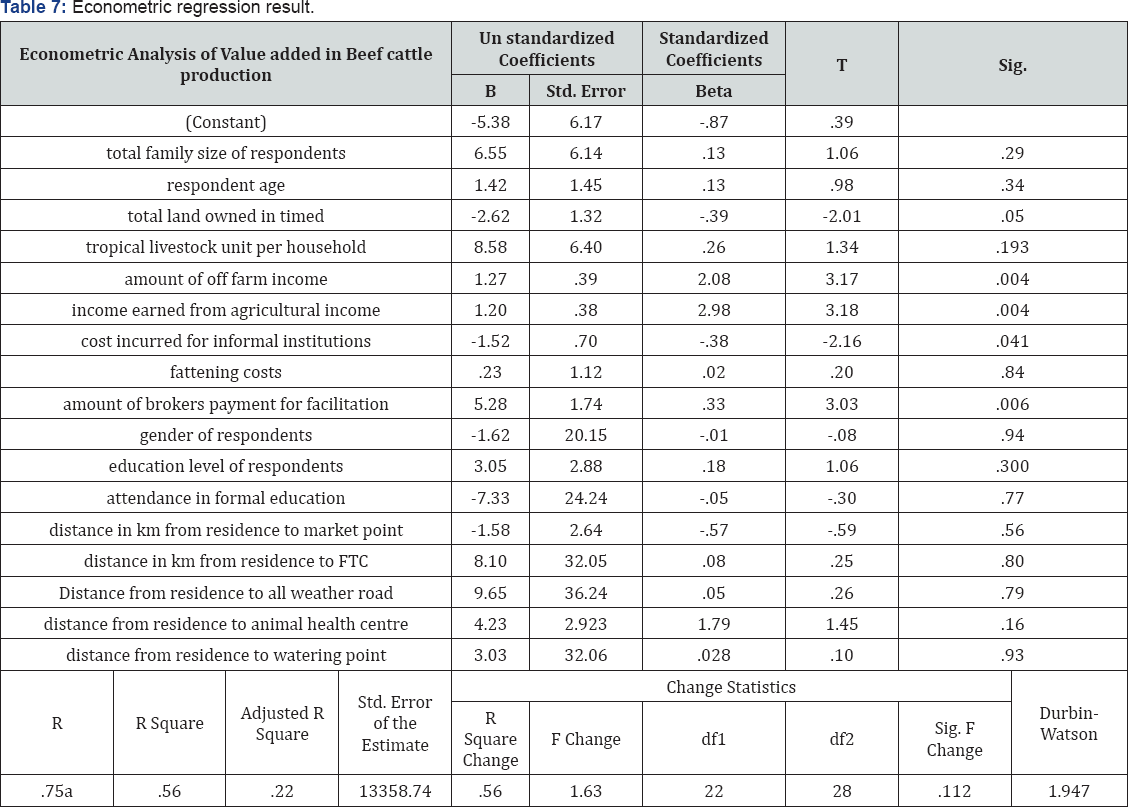
Factors affecting level of value added in Beef cattle production
i. Land Owned in timad (1Timad=1/4ha): (-2.62). Total land owned by farmers is one of explanatory variable significantly and negatively affected the extent of value added in beef cattle fattening in the the district. The parameter estimate of the variable land resource owned was -2.62 that suggest one unit increment in timad of total land owned results in more than twofold decrease in extent of value added in beef cattle value chain by small scale farmers, holding all the other explanatory variables constant. Since the farmers that acquainted with less land resource size in the district gives more attention for beef fattening and its value addition practices, manage the livestock resource in a better way as one of the best income earning activities and consequently able to earn more income than the farmers that owns more sized land resource. The result is line with the finding of [4] that stated income earned from potato negatively correlated with level total land owned.
ii. Amount of offarm income in Birr (-1.08): The amount of offarm income earned was one of the explanatory variables assumed to affect the level of the level of value added. The type of offarm income considered in the study comprised of trade, daily labour activities, permanent employee, carpentry and other non agricultural activities. The parameter estimate for amount of offarm income earned at household level was -1.08 and confirmed its negative correlation with level of value added in beef cattle production. The study result confirmed that one unit increase in amount of offarm income earned by small scale farmers, the amount of value added in beef cattle decrease by more than 1 unit, holding others independent factors constant.
iii. Amount of agricultural income (1.202): In the study extent of agricultural income earned by farmers considered as one of explanatory variables regressed as factor to affect level of value added in beef cattle production in the district. The parameter estimate for the variable termed amount agricultural income valued 1.2 with positive correlation with dependant variable level of value added. The study result indicated that for a unit increase in extent of Agricultural income results in more than one unit increment in level of value added in beef cattle value chain, holding other variables constant. The study confirmed that it is possible to optimize the beef value addition through enabling the small scale farmers abled to earned better income.
iv. Cost incurred in informal institutions (-1.52): The parameter estimate for the variable costs incurred in informal institutions was -1.52. The costs incurred in informal institutional expenditures referred to summation of costs of weeding, edir, ekub, tilosh, meles, funeral ceremonies and the like. The study result confirmed that one unit increment in cost incurred for informal institutional matters, decrease the extent of value added by small scale farmers by more than 1.5 factors, holding other explanatory variables constant. It was concluded that when the small scale farmers indulged with informal institutional activities and incurring more costs in related issues, their time devoted, money invested and care given for fattening for value addition in beef cattle decrease, consequently the level of value added become low in the sector. Hence, some informal institutional task negatively affects the performance of beef value addition, it is advisable to create awareness for farmers on effects informal institutions on beef value addition and that could optimize the sector performance.
v. Amount of payment for brokers (5.28): The parameter estimate for the variable extent of payment for broker was 5.28. The study result justified that one Birr increase in extent of payment for broker payment, the amount of value added increase by more than 5 times, holding others factors constant. The study also indicated that producers forced to pay for brokers for market facilitation and there by maximize their value added in beef production. Since the small scale farmers are not in a position to obtain market information needed for marketing their beef cattle in the value chain, their significance in price setting of fattened animal is minimal due to these and related reasons producers are also forced to pay for brokers for market facilitation. Since the brokers did not add any value in the beef production for further technology scaling up and simply exploit the benefit belongs to producers and it is possible make function the beef value without brokers, brokers lengthens the value chain and complicate the system, it is advisable to systematic intervention of government for cutting off brokers intervention in the value chain.
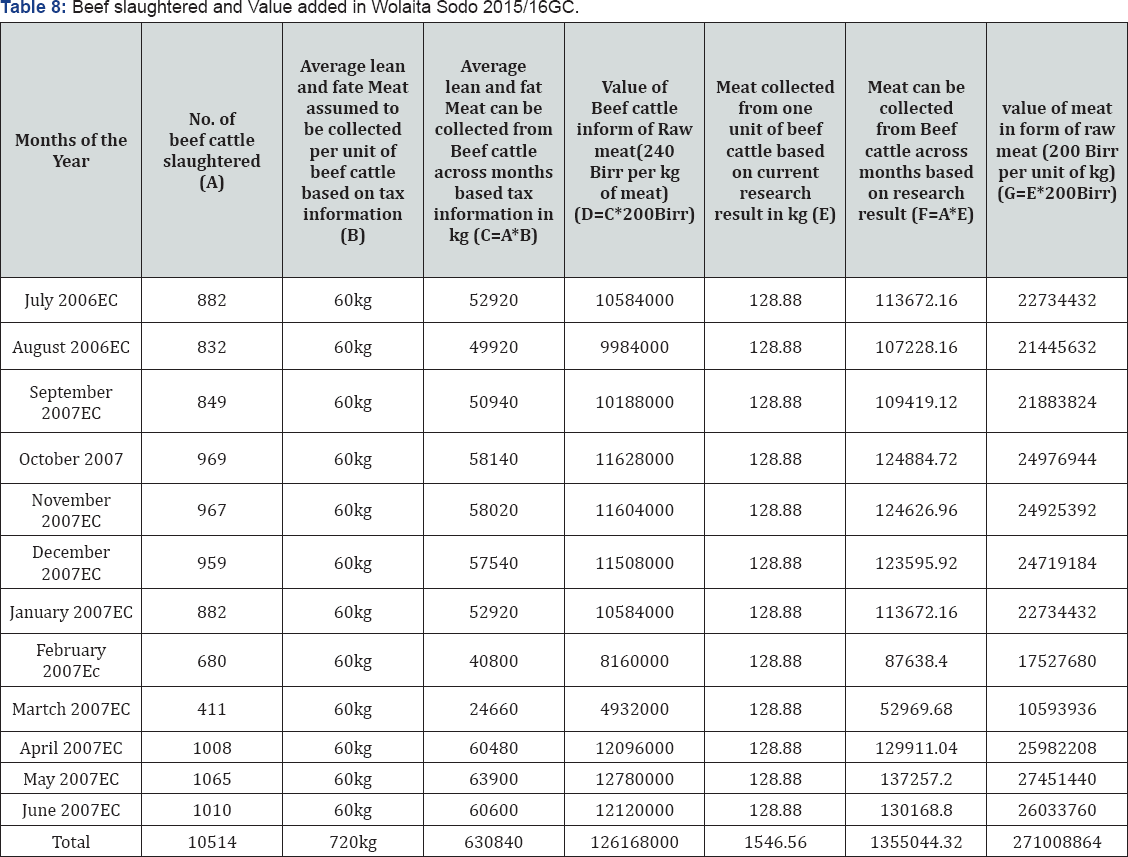
Source: abattoir of Wolaita Sodo town, 2015/16.

The table 8 above indicated that the economic value of meat slaughtered in one fiscal year in Wolaiyta Sodo was more than 0.27 Billion Ethiopian Birr (equivalent to more than 10037365.33 Million American Dollars). This indicated that Meat production in particular and beef value chain in general plays a vital role in economy of the area. This figure 2 only considers that slaughtered officially at Governmental abattoir and did not consider beef chattels slaughtered during festivals and informally. Total number of beef cattle slaughtered in one fiscal year exceeds ten thousand in Wolaita Sodo and it shows more than one thousand increment in the two consecutive years from 2015 to 2016 GC. The maximum and minimum number of beef cattle slaughtered in the town was 1065 and 832, respectively. The major reason for higher number of beef cattle slaughtered in the districts were existence of festivals and breaking of fasting ,while the major cause for decrease in number of beef cattle slaughtered was lack of financial capacity to consume meats and the months around august was economically dearth period in the district.
The graphical presentation illustrated above indicated that the number of beef cattle slaughtered varies across season and years in Wolaita sodo town. The number of beef cattle slaughtered in addition in the consecutive year exceeds one thousand beef cattle; this indicated that the meat demand soars every year in the area due to economic booms, population growth and infrastructural development. The primary data collected also indicated that the demand of raw meat increase having been parallel with prices of meat. Even if meat is considered luxury good informally, the study justified that it is necessity good for with the demand increase in line with increase price. Since raw meat with its special ingredients is the most important traditional meal and the way of life in Wolaita area, demand of meat consumed increase with increased price.
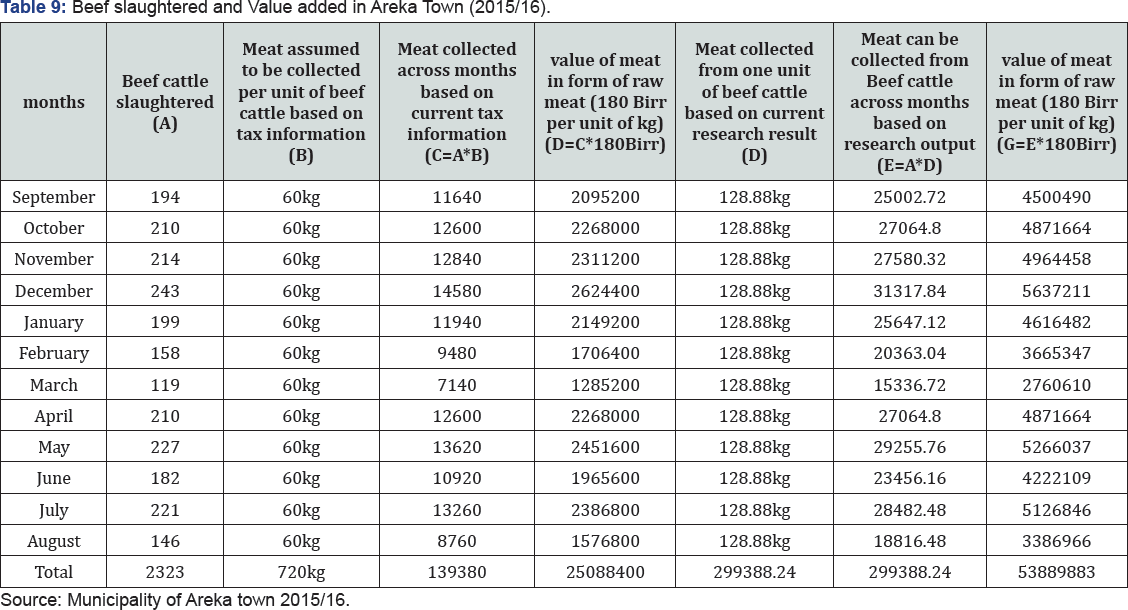
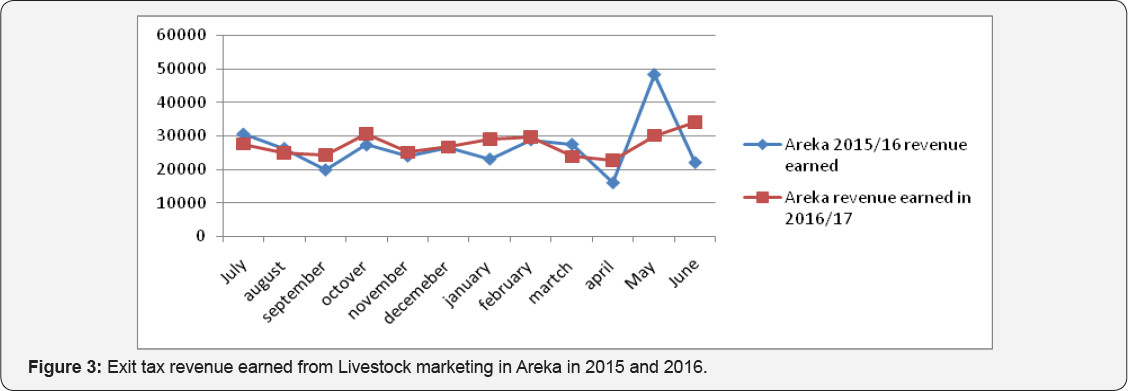
The table 9 above indicated that the economic value of meat slaughtered in one fiscal year in Areka town is about more than 53 Million Ethiopian Birr (equivalent to more than 1.9 United USA Dollars). This indicated that Meat production in particular and beef value chain in general plays a vital role in economy of the area. This figure 3 only considered that beef cattle slaughtered officially at Governmental abattoir and did not consider beef cattle's slaughtered during festivals and informally. The highest and lowest numbers of beef cattle slaughtered were 243 and 119 in December and March, 2015. The major reason for variation in number of beef cattle slaughtered were institutional occasions, economic reasons and other related factors. The economic reason for increment around December was the season known as income earning seasons that make the society to consumer demand more beef cattle meat.
The institutional reason that forced the community to decrease the number of beef cattle slaughtered and meat consumed was fasting for Christians. The hidden value of meat produced in the district estimated to be more than 28 million Ethiopian Birr that calculated as difference between meat values estimated based on research result and officially taxed. The extent of meat collected and taxed from one unit of beef cattle slaughtered was 60kg, but the research study undertaken confirmed that it exceeds 128kg.
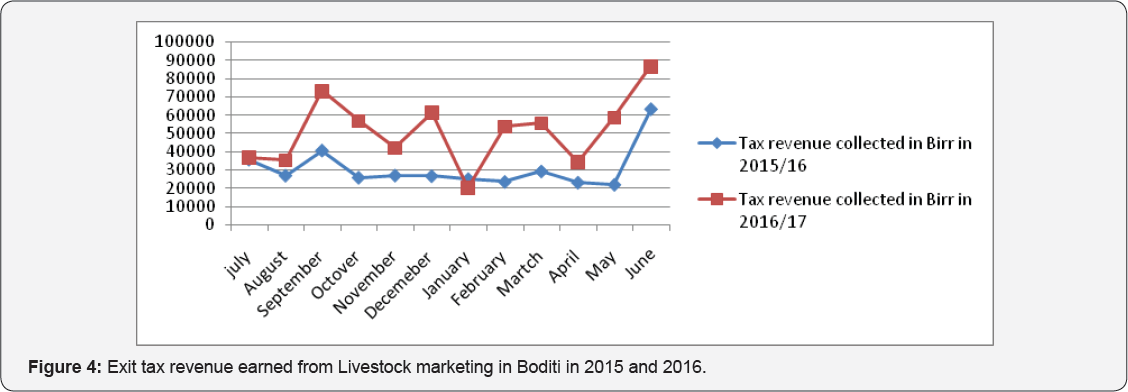
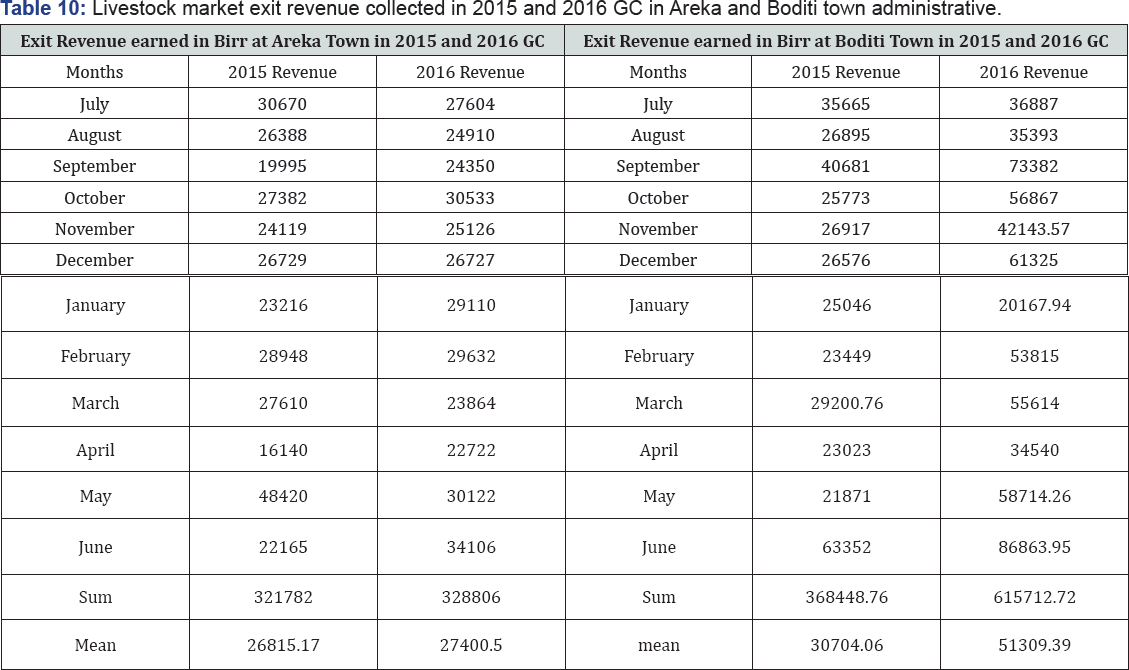
The study result indicates that the extent of exit market tax revenue collected from Areka and Boditi market point varies across months of the year. The annual livestock exit tax market revenue earned from Areka and Boditi market point were in excess of 0.32 million in Areka in 2015 and 2016 in each fiscal years (Table 10). The annual exit tax revenue from livestock market in Boditi market town was more than 0.36 million and 0.61 million Ethiopian Birr in 2015 and 2016 fiscal years (Figure 4). The study information justified that livestock has significant role in economy of the town administrative in particular and the country economy in general. The two year average result indicated that the highest livestock exit tax revenue collected in June and September at Boditi market point while the lowest revenue collected was earned in January.
The study result indicated also that it was highest in May and September, but it was lowest in May at Areka town. The June and September months of year increment in revenue earned from exit tax related to New Year celebrations, Meskel holidays and higher capital demand for educational fees, informal institutional fees and other investments in the months. These seasons are also known as feed surplus seasons that provoked the farmers to supply their livestock to market with marketable body condition. The lowest revenue earned in January and August indicated that months are known as feed shortage seasons in the district and farmers showed reluctance in feed shortage season where the body of livestock was not at marketable position.
Even if the livestock sector plays a significant role in specific town administrative, there was no market infrastructures developed for livestock market in the area that could optimize the sector development and revenue maximization in the district. Hence it was advisable to develop market structures in the market point (water structures, feeding point and appropriate market shade) that is believed to optimize the sector development in the district. The study result pointed out that due to economical, informal institutional and social cases, the extent of revenue collected by Areka town administrative showed 45% positive change (increase) and 28% negative change (decrease) s from the calculated mean revenue collected. In the same fashion, exit tax revenue collected showed variation from calculated mean due to different reasons mentioned in proportion of 83% up and 44% down as of Boditi town administrative.
Conclusions and Recommendations: The study result showed that farmers, hotels and restaurants, government, brokers, traders and consumers were the major beef value chain actors. The economic value of meat produced annually in Wolaita Sodo and Areka town exceeds 0.3 billion Ethiopian Birr (equivalent to 10 million USA dollars) and 53 million Ethiopian Birr (equivalent to 1.9 million USA dollars) respectively. The total number of beef cattle slaughtered in one fiscal year was more than 10 thousand and two thousand in Wolaita Sodo and Areka Town, respectively. The study confirmed that number of beef cattle slaughtered in towns varies across season. The factors that significantly affected the extent of beef cattle slaughtered and meat produced comprised of availability of informal institutions celebrated such as Meskel, new year, "’ekub,””edir” ,weeding, circumcision, Christmas and income earning capability of communities in the district. The major source of beef cattle of small scale farmer for beef value addition through fattening were beef cattle purchased from market (82.5%) and ox kept at home (32.5%).
The study indicated that livestock also plays vital role by supporting town administrative as revenue source inform of exit tax at marketing points. The annual revenue collected from livestock was more than one million Ethiopian Birr in Areka. The econometric regression result justified that extent of value added in beef production depends on total land owned, amount off-farm and agricultural income earned annually at household level ,amount of brokers payment for market facilitation service, extent of costs incurred in informal institutional circumstances. From explanatory variables regressed over level of value added, amount of off-farm and agricultural income earned annually and extent of payment made to brokers positively affected the extent of value added in beef production, while amount cost incurred for informal institutional cases and total land owned negatively affected value added by producers in beef production.
Recommendations: Based from study result the following things are crucial to be undertaken so as to optimize beef value chain development and optimize the small-scale benefits and the sector productivities
a. Training of small scale farmers and other subject matter specialists
b. Policy supporting and specializing with respect to resource and value added
c. Market structure development
d. optimizing the informal institutional cases linked positively with beef value chain,
e. improving credit access for small scale farmers
f. establishing in cooperatives
g. Promoting value addition practices in beef cattle production.
Discussion
Value addition refers to the act of adding values to a product to create form, place, and time utility which increase the customer value offered by a product or service. It is an innovation that improves an existing product or introduces new products or new product uses. Income growth, urbanization, and technological advances, along with ever expanding global trade in agriculture, have contributed to a growing global demand for processed products with added values. The emerging trend for processed agricultural products in the global market creates opportunities for smallholder farmers in the developing countries to benefit from such opportunities by linking their activities to value chains through vertical and horizontal linkages. Yet, there are ample opportunities for smallholder farmers in the domestic markets for them to supply products with added values [5].
The livestock value chain can be defined as the full range of activities required to bring a product (e.g. live animals, meat, milk, eggs, leather, fiber, manure) to final consumers passing through the different phases of production, processing and delivery. It can also be defined as a market-focused collaboration among different stakeholders who produce and market value-added products [6]. In Ethiopia, the current per caput consumption of meat is 13.9 kg year; being lower than the African and the world per capita averages, which are 27 g/year and 100 kg/year, respectively [6,7].
Ethiopia ranks first in Africa and tenth in the world for livestock population head count and from witch cattle largest share of this population of the country. Now a day the demand for livestock products in SubSaharan and eastern African countries is increasing tremendously. However, the overall performance of beef sector in Ethiopia is very low as compared to other countries in east Africa and world standard; this is due to of weak value chain of the beef sector in the country. Therefore, undertaking the beef value chain analysis and upgrading the beef sector is one footstep [8].
The Ethiopian livestock and product value chain and marketing system is operating in an environment characterized by several constraints that needs the attention and action of the government and other non-governmental development organizations. The problem could be because of the constraints in the value chain and marketing system of exporters themselves, poor market infrastructures like road, seasonality in marketing and production, competition of the domestic and the export sector, market entry barriers, distant marketing points, high transaction costs, information asymmetries and unfriendly relations between actors [3,9,10].
Beef cattle are one of a few agricultural commodities in Ethiopia from which the country earn foreign currency through both live animal and processed livestock products export and also most of small scale farmers are engaged in raring it to fulfil their daily needs and economic gaps. The main objective of this study is to investigate factors affecting level of value added in beef cattle production, understand major value chain actors and their function the chain and identify challenges and opportunities of beef cattle production in the specific district. In both rural and urban areas, smallholder cattle fattening is emerging as an important source of income. In rural Ethiopia, cattle fattening is based on locally available feed resources [7].
Specific Objectives
a. To investigate factors affecting level of value added in beef cattle production
b. To investigate economic value of Beef cattle production in the district
c. To identify beef cattle value chain actors and their function in the chain
Wolaita Sodo, Areka and Boditi twons are towns under Wolaita zone in southern part of Ethiopia. Wolaita Sodo is a town and separate Woreda in south-central Ethiopia. The administrative center of the Wolaita Zone of the Southern Nations, Nationalities, and Peoples Region, Sodo has an elevation between 1600 and 2100 meters above sea level (Figure 5). It was part of the former Sodo woreda which included Sodo Zuria which completely surrounds it. Areka is a town in southern part of Ethiopia and located in the Wolaita Zone of the Southern Nations, Nationalities and Peoples Region some 300 kilometers southwest of the capital, Addis Ababa. Areka town has latitude and longitude of and an elevation of 1774 meters above sea level. It is the administrative center of Boloso Sore woreda.
Boditi is a town Located in the Wolaita Zone of the Southern Nations, Nationalities, and Peoples Region, Ethiopia. This town has a latitude and longitude of 6°58'N 37°52'E with an elevation of 2050 meters above sea level. It the administrative center of Damot Gale woreda.
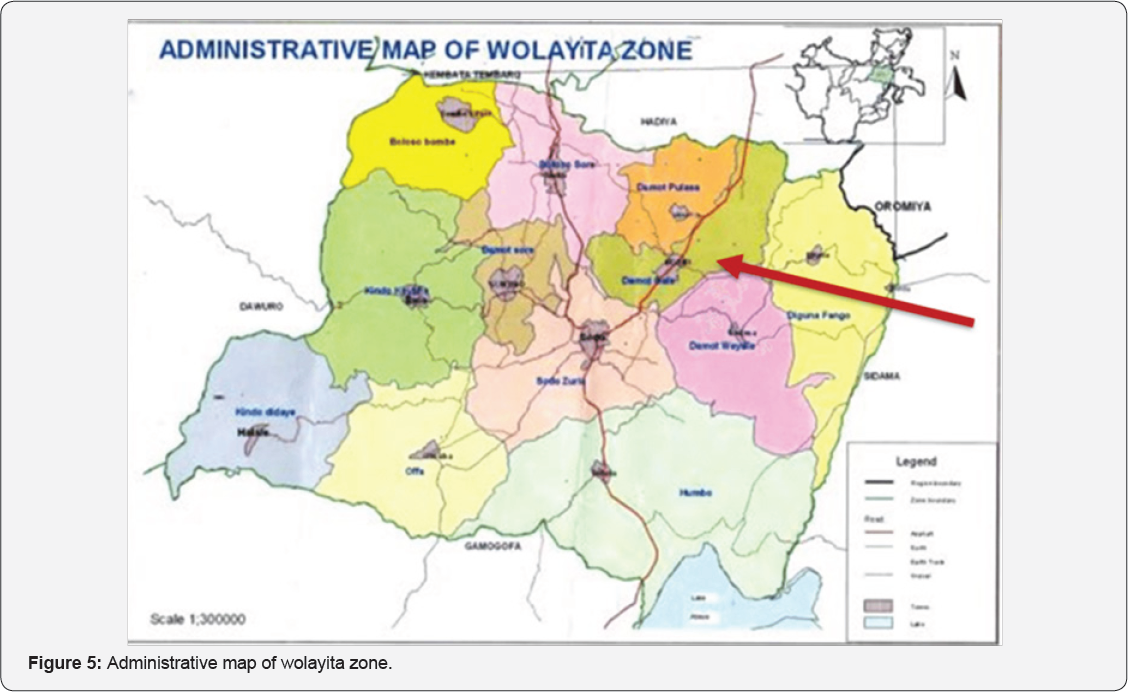
Recommendations
Based from study result the following things are crucial to be undertaken so as to optimize beef value chain development and optimize the small-scale benefits and the sector productivities
a. Training of small scale farmers and other subject matter specialists
b. Policy supporting and specializing with respect to resource and value added
c. Market structure development
d. optimizing the informal institutional cases linked positively with beef value chain,
e. improving credit access for small scale farmers
f. establishing in cooperatives
g. Promoting value addition practices in beef cattle production.
For more articles in Open Access Journal of Environmental Sciences & Natural Resources please click on: https://juniperpublishers.com/ijesnr/index.php



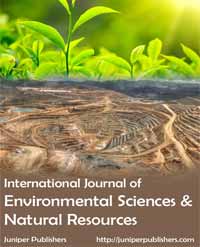
Comments
Post a Comment